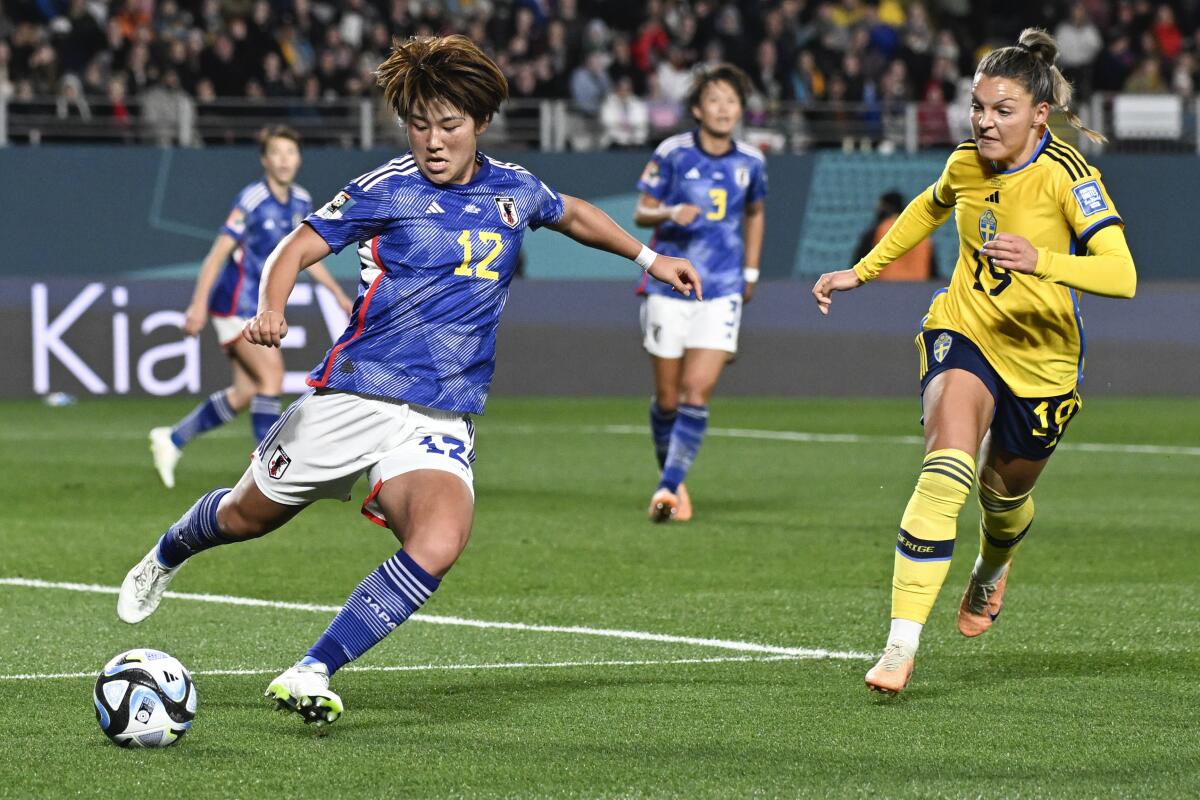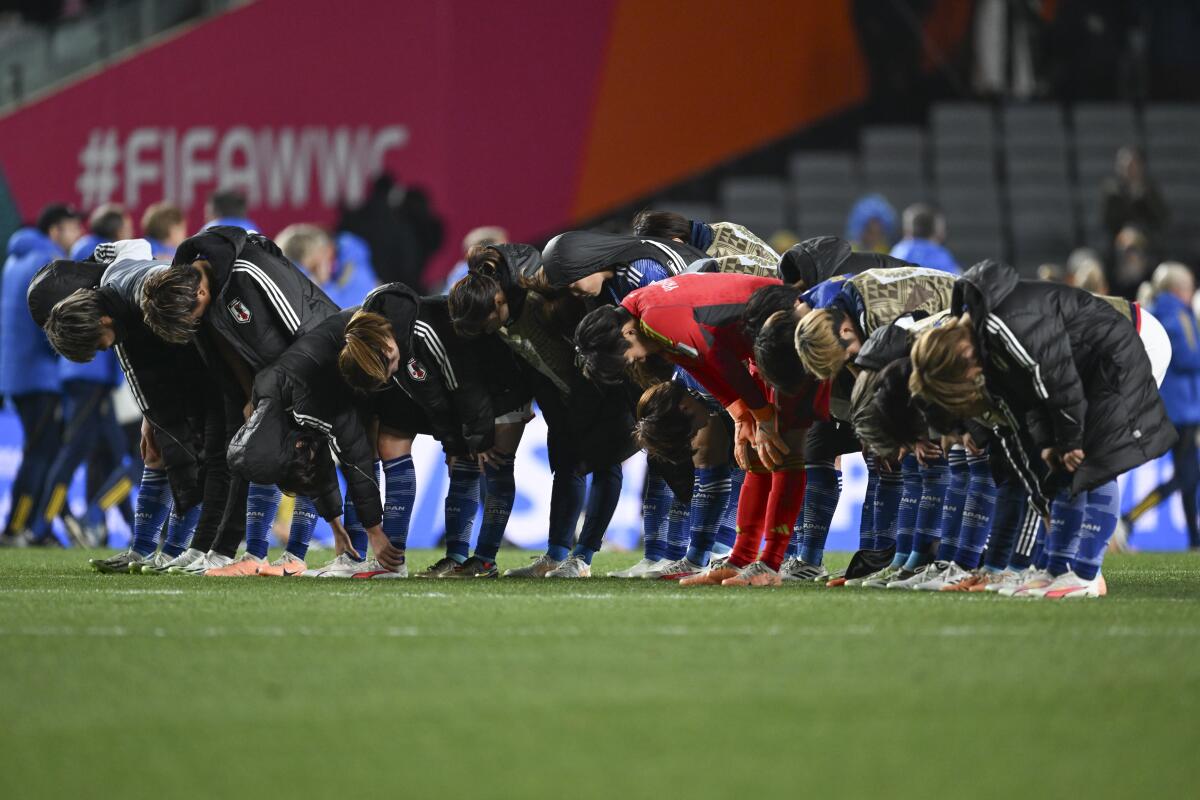World Cup: Women’s soccer will soon crown a new queen after Sweden beats Japan

- Share via
AUCKLAND, New Zealand — Never has a women’s World Cup marked so dramatic a changing of the guard as this summer’s tournament in Australia and New Zealand.
The world’s two top-ranked teams, the No. 1 U.S. and No. 2 Germany, didn’t make it past the round of 16. They had combined to win six of the first eight women’s World Cups; never before had they both failed to reach the final in the same tournament.
Seventh-ranked Canada, the reigning Olympic champion, and No. 8 Brazil each went out in the group stage. Then the ninth-ranked Netherlands and No. 11 Japan, the only former champion to make it past the round of 16, bowed out in the quarterfinals Friday.
Just half the world’s top 10 teams are still here, and of the six countries remaining entering the weekend, only Sweden has been to a World Cup final before
None of the six has won one.
Women’s soccer has flipped upside down Down Under and the chief beneficiary has been Sweden, which knocked off the top-ranked Americans on penalty kicks in the round of 16, then ran its scoreless streak to 428 minutes before conceding a goal late in a 2-1 win over Japan in its quarterfinal.
The queens are dead. Long live the queens!
Salma Paralluelo scored late in extra time to give Spain a 2-1 win over the Netherlands, pushing it into the 2023 Women’s World Cup semifinals.
Sweden has won here with a stifling defense and an opportunistic offense that has scored more than half of its goals off set pieces or penalty kicks. The Swedes got one of each against Japan, with Amanda Ilestedt slotting home a first-half rebound after Japan blocked three shots in the box following a long free kick. It was Ilestedt’s fourth goal of the tournament.
Filippa Angeldal doubled the lead early in the second half, scoring on a penalty kick following a handball call.
Honoka Hayashi got Japan on the scoreboard in the 87th minute, the first goal Sweden has allowed since early in the second half of its group-stage opener, which was the only time the Swedes have trailed in the tournament.
Minutes earlier, Riko Ueki had missed a penalty, banging her try off the crossbar, a rare Japanese mistake that proved costly when Hayashi scored what could have been the tying goal.
Before it was vanquished, Japan was among the revelations of the tournament. Not because of its success — Japan won a World Cup in 2011 and made the final four years later — but because of its play.

The Nadeshiko — the Japanese team’s nickname, chosen via a contest, was inspired by the Japanese term for the personification of an idealized Japanese woman — lead the World Cup in scoring with 15 goals and, through its first four games, had never trailed, winning by multiple goals each time.
It was a remarkable rebound for a team that was eliminated in the round of 16 in 2019 and lost twice in the Olympics that it hosted two years ago.
The statistics don’t tell the real story, though, because the dynamism and beauty of the team’s play can’t be expressed with numbers. Japan has been a haiku in motion: disciplined, artistic and minimalist. Every touch has a purpose, every pass has a target.
Brazil may have pioneered the beautiful game, but Japan’s women are perfecting it, stripping away much of the flourish but keeping the joy, passion and purpose.
And it got there by setting a solid foundation at the grassroots level and building up from there.
“It’s the technical skills that keep Japan very competitive,” Tom Byer, a former professional player who turned coach in Japan, told Soccer America’s Mike Woitalla. “We have focused primarily on ensuring that kids who play the sport here get the technical component.”
Fourteen of the 23 players on Japan’s team play in the domestic WE League, including Hinata Miyazawa, the World Cup’s leading scorer with five goals, and Mina Tanaka, who is tied for the tournament lead with three assists. Japan has thrived by getting the basics — ball-handling, passing, defense, chemistry — right and putting the team before any individual.

In some ways, they are a mirror opposite of the brash, physical and confident American teams that spent so much time atop the sport.
“They’re so disciplined and very structured in the way they play offense and defense,” Norway’s Caroline Graham Hansen said after her team was eliminated by Japan in the round of 16.
That’s really the only way Japan can compete. Its players average 5-foot-4 and 124 pounds; the average for Sweden is 5-6 and 138 pounds, although the differences appeared much starker on the field Friday.
The 12-team WE League — the initials stand for Women’s Empowerment — was launched in June 2020, three months into the COVID-19 pandemic and has struggled to catch the public’s imagination. Average attendance was 1,344 in the just-completed third season and two days before the World Cup kicked off, Japan was facing a TV blackout of the tournament, something coach Futoshi Ikeda — who replaced Asako Takakura three months after the Tokyo Olympics — warned would harm the development of the sport there.
NHK, Japan’s viewer-supported public broadcaster, eventually agreed to air the games and was rewarded when the team reached the quarterfinals.
Japan can’t afford to let even one talented player go undeveloped since the numbers are so small, with about 30,000 registered players in the country compared to the more than 1 million girls who play soccer in the U.S. But the entire country is smaller than California, so the top players and teams compete against one another regularly, which helps raise the level of play.
When the final whistle sounded Friday, ending the team’s magical run, many of Japan’s players dropped to the turf in frustration and exhaustion. Minutes later they rose, lined up near midfield and bowed to the crowd, before heading off into the chilly night and, eventually, to their flights home.

Sweden, meanwhile, whose victory was again marked by an ABBA soundtrack on the stadium public-address system, will go on to face Spain in the semifinals. The Spanish beat the Netherlands, the World Cup runner-up four years ago, in extra time in its quarterfinal.
Whatever happens next, one thing is sure: When this tournament ends next weekend, it will do so with a new champion being crowned, the first time that’s happened since Japan’s coronation in 2011.
The queens are dead. Long live the queens!









